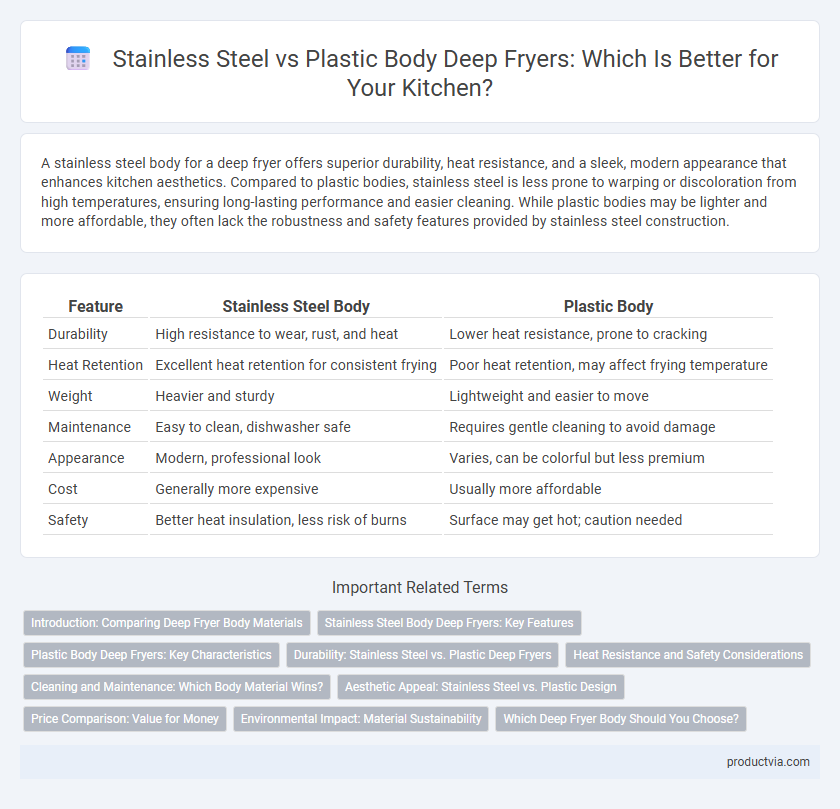A stainless steel body for a deep fryer offers superior durability, heat resistance, and a sleek, modern appearance that enhances kitchen aesthetics. Compared to plastic bodies, stainless steel is less prone to warping or discoloration from high temperatures, ensuring long-lasting performance and easier cleaning. While plastic bodies may be lighter and more affordable, they often lack the robustness and safety features provided by stainless steel construction.
Table of Comparison
| Feature | Stainless Steel Body | Plastic Body |
|---|---|---|
| Durability | High resistance to wear, rust, and heat | Lower heat resistance, prone to cracking |
| Heat Retention | Excellent heat retention for consistent frying | Poor heat retention, may affect frying temperature |
| Weight | Heavier and sturdy | Lightweight and easier to move |
| Maintenance | Easy to clean, dishwasher safe | Requires gentle cleaning to avoid damage |
| Appearance | Modern, professional look | Varies, can be colorful but less premium |
| Cost | Generally more expensive | Usually more affordable |
| Safety | Better heat insulation, less risk of burns | Surface may get hot; caution needed |
Introduction: Comparing Deep Fryer Body Materials
Stainless steel body deep fryers offer superior durability, heat resistance, and a sleek, professional appearance compared to plastic body models. Plastic bodies tend to be lighter and more affordable but may lack long-term resilience and heat tolerance, potentially affecting safety and performance. Choosing between stainless steel and plastic body deep fryers depends on factors like kitchen environment, usage frequency, and budget preferences.
Stainless Steel Body Deep Fryers: Key Features
Stainless steel body deep fryers offer exceptional durability and resistance to corrosion, making them ideal for long-term use in both home and commercial kitchens. Their sleek, heat-resistant surface ensures safety during frying, while providing easy cleaning and maintaining hygiene standards. Stainless steel models often feature reinforced construction that withstands high temperatures, enhancing overall performance and longevity compared to plastic body alternatives.
Plastic Body Deep Fryers: Key Characteristics
Plastic body deep fryers offer a lightweight and affordable alternative to stainless steel models, often featuring insulated exteriors that remain cool to the touch, enhancing user safety. These fryers typically have compact designs ideal for small kitchens and use durable, heat-resistant plastics that resist discoloration and cracking over time. Although less robust than stainless steel, plastic body deep fryers provide efficient oil heating performance and are easier to clean due to their smooth surfaces.
Durability: Stainless Steel vs. Plastic Deep Fryers
Stainless steel deep fryers offer superior durability compared to plastic-bodied models, resisting cracks, warping, and discoloration under high heat and frequent use. The metal's corrosion resistance and robustness ensure a longer lifespan, making it ideal for both home kitchens and commercial environments. In contrast, plastic deep fryers may degrade over time due to heat exposure, reducing overall performance and durability.
Heat Resistance and Safety Considerations
Stainless steel bodies for deep fryers offer superior heat resistance, maintaining structural integrity at high frying temperatures and reducing deformation risk. Their non-combustible nature enhances overall safety, minimizing fire hazards compared to plastic bodies that may warp or emit toxic fumes under prolonged heat exposure. Choosing stainless steel ensures durability and safer operation during intense cooking sessions.
Cleaning and Maintenance: Which Body Material Wins?
A stainless steel body for deep fryers offers superior durability and resistance to stains, making cleaning easier and more effective compared to plastic bodies. Stainless steel surfaces can withstand rigorous scrubbing and high temperatures without degrading, which reduces long-term maintenance efforts. Plastic bodies, while lighter, tend to retain oil stains and require gentler cleaning to prevent scratches and discoloration.
Aesthetic Appeal: Stainless Steel vs. Plastic Design
Stainless steel bodies on deep fryers offer a sleek, modern look with a polished finish that resists stains and enhances kitchen aesthetics. Plastic bodies provide a lightweight option available in various colors and designs but may lack the premium feel and durability of metal. Choosing stainless steel often elevates the appliance's appearance while ensuring long-lasting visual appeal in contrast to the more budget-friendly, but less sophisticated, plastic exterior.
Price Comparison: Value for Money
Stainless steel deep fryers generally have a higher upfront cost but offer superior durability, heat retention, and resistance to corrosion, providing better long-term value for money. Plastic-bodied deep fryers are more affordable initially but may suffer from reduced lifespan, lower heat resistance, and less robustness, potentially leading to more frequent replacements. Consumers prioritizing durability and performance often find stainless steel models more cost-effective over time despite the higher price.
Environmental Impact: Material Sustainability
A stainless steel body deep fryer offers greater material sustainability due to its recyclability and longer lifespan, reducing waste over time. In contrast, plastic body deep fryers often rely on non-renewable petrochemicals and contribute to microplastic pollution when discarded. Choosing stainless steel helps minimize environmental impact through enhanced durability and eco-friendly end-of-life recycling options.
Which Deep Fryer Body Should You Choose?
Stainless steel deep fryer bodies offer superior durability, heat resistance, and a sleek, professional appearance compared to plastic bodies, which are often lighter and more affordable but less durable under high heat conditions. Choosing a stainless steel body ensures longevity and easier cleaning, making it ideal for frequent frying and commercial use. Plastic bodies may be suitable for occasional home use due to their lightweight and cost-effectiveness, but they tend to wear out faster and can warp or discolor over time.
Stainless steel body vs plastic body for deep fryer Infographic

 productvia.com
productvia.com